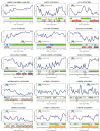Co-Transcriptional RNA Processing in Plants: Exploring from the Perspective of Polyadenylation
- PMID: 33804866
- PMCID: PMC8037041
- DOI: 10.3390/ijms22073300
Co-Transcriptional RNA Processing in Plants: Exploring from the Perspective of Polyadenylation
Abstract
Most protein-coding genes in eukaryotes possess at least two poly(A) sites, and alternative polyadenylation is considered a contributing factor to transcriptomic and proteomic diversity. Following transcription, a nascent RNA usually undergoes capping, splicing, cleavage, and polyadenylation, resulting in a mature messenger RNA (mRNA); however, increasing evidence suggests that transcription and RNA processing are coupled. Plants, which must produce rapid responses to environmental changes because of their limited mobility, exhibit such coupling. In this review, we summarize recent advances in our understanding of the coupling of transcription with RNA processing in plants, and we describe the possible spatial environment and important proteins involved. Moreover, we describe how liquid-liquid phase separation, mediated by the C-terminal domain of RNA polymerase II and RNA processing factors with intrinsically disordered regions, enables efficient co-transcriptional mRNA processing in plants.
Keywords: RNA processing; coupling regulation; gene expression; liquid–liquid phase separation (LLPS); plant; polyadenylation; transcription.
Conflict of interest statement
The authors declare no conflict of interest.
Figures



References
Publication types
MeSH terms
Substances
LinkOut - more resources
Full Text Sources
Other Literature Sources

